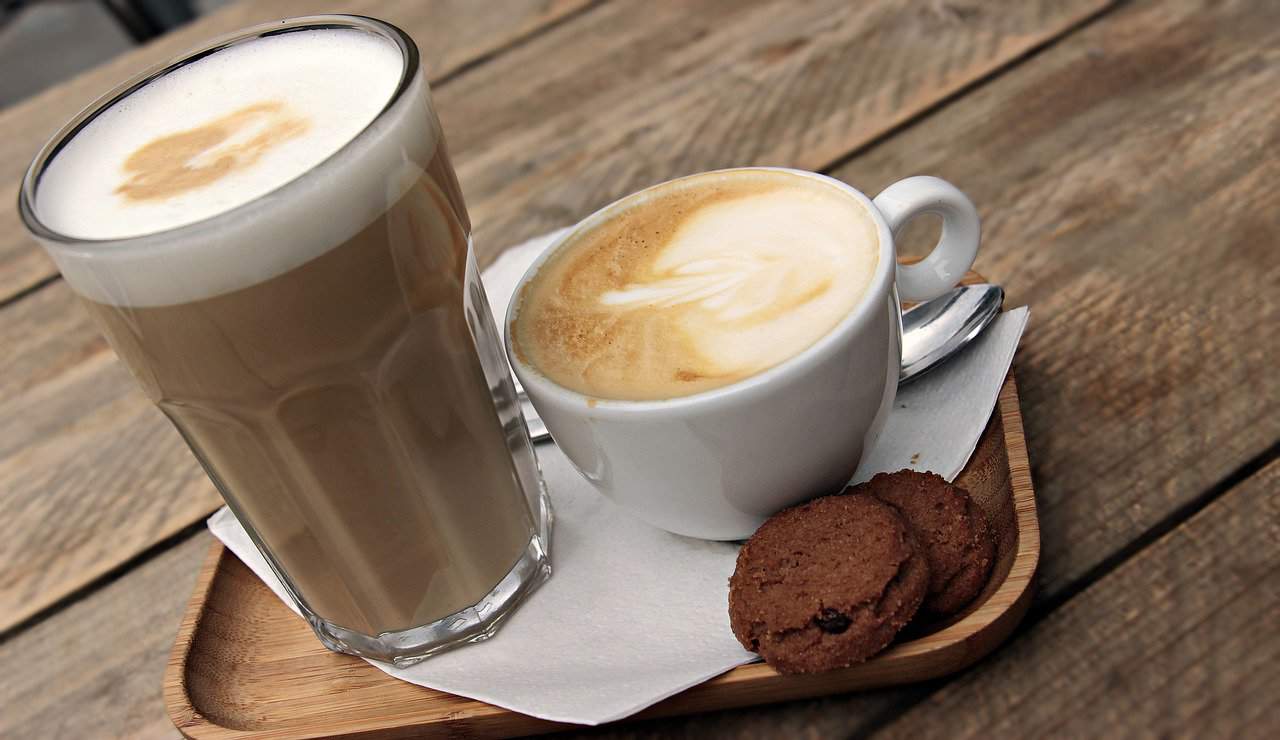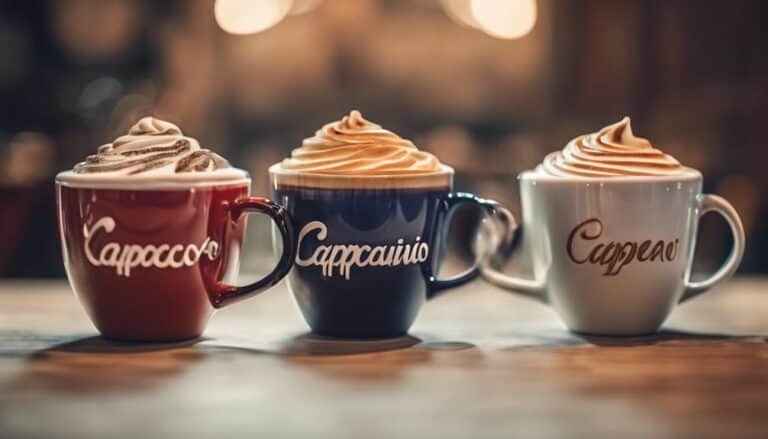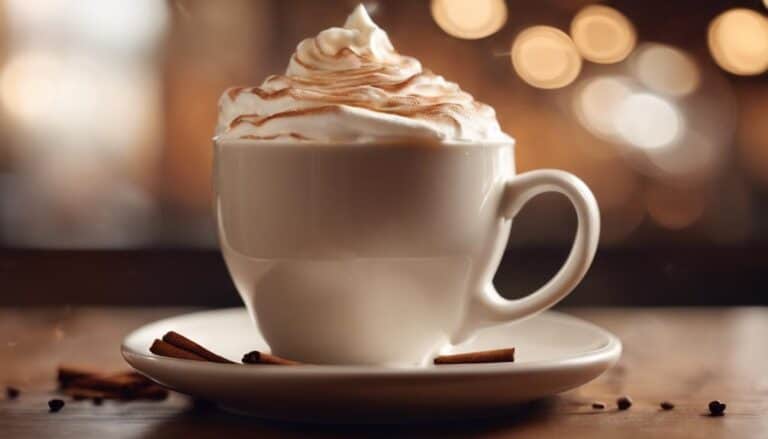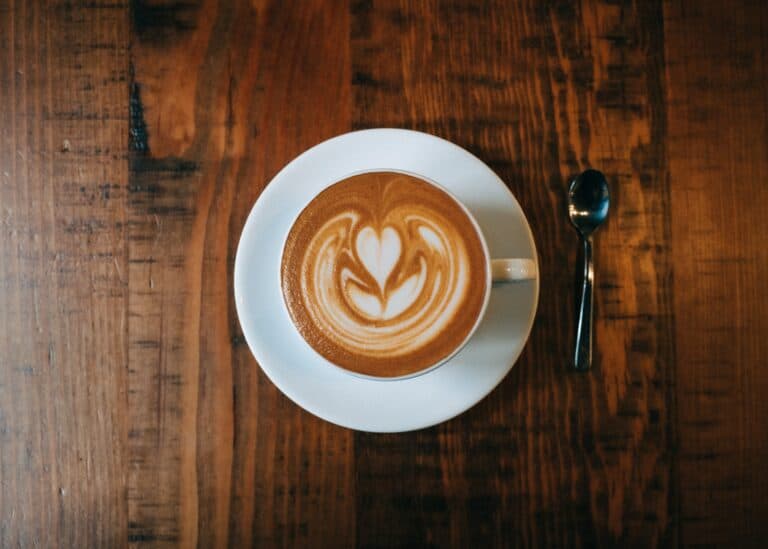Cappuccino vs. Latte: Understanding the Differences

Cappuccino and latte are two of the most popular coffee drinks in the world. Both drinks are made with espresso and milk, but there are some key differences between the two. Understanding these differences can help you choose the drink that best suits your taste preferences.
The main difference between cappuccino and latte is the milk content. A cappuccino is a smaller drink that contains less milk than a latte. It is made with a shot of espresso, steamed milk, and a layer of frothed milk on top. A latte, on the other hand, is a larger drink that contains more milk. It is made with a shot of espresso and steamed milk, with a small layer of frothed milk on top.
The Basics of Cappuccino and Latte
Cappuccino and latte are two of the most popular espresso-based drinks. Both drinks contain espresso and milk, but the milk to coffee ratio and the way they are prepared are different. In this section, we will explore the basics of cappuccino and latte.
Cappuccino
Cappuccino is an Italian coffee drink that is traditionally made with equal parts of espresso, steamed milk, and milk foam. The name “cappuccino” comes from the color of the drink, which resembles the color of the robes worn by Capuchin monks.
Cappuccino is typically served in a small cup, usually between 150ml to 180ml, and is made by pouring a shot of espresso into the cup, followed by adding steamed milk and milk foam on top. The ratio of espresso, steamed milk, and milk foam in a cappuccino is usually 1:1:1, which means that each ingredient makes up one-third of the drink.
Latte
Latte is another Italian coffee drink that is made with espresso and steamed milk. The word “latte” means milk in Italian, and the drink is named after the large amount of milk used in its preparation.
Latte is typically served in a larger cup than cappuccino, usually between 240ml to 360ml, and is made by pouring a shot of espresso into the cup, followed by adding steamed milk on top. The ratio of espresso to steamed milk in a latte is usually 1:2, which means that the amount of milk used is double the amount of espresso.
The Differences
The main difference between cappuccino and latte is the milk to coffee ratio. Cappuccino has a higher concentration of espresso and less milk than latte. Cappuccino also has more milk foam than latte, which gives it a thicker and creamier texture.
Another difference between cappuccino and latte is the size of the drink. Cappuccino is typically served in a smaller cup than latte, and it has a stronger and bolder flavor. Latte, on the other hand, is a milder and smoother drink that is usually served in a larger cup.
In summary, cappuccino and latte are two of the most popular espresso-based drinks that are made with espresso and milk. The main difference between the two is the milk to coffee ratio, with cappuccino having a higher concentration of espresso and less milk than latte. Both drinks are delicious and can be enjoyed at any time of the day.
The Ingredients and Their Ratios
Cappuccino and latte may seem similar at first glance, but the two drinks are quite different in terms of their ingredients and ratios. Both drinks are made with espresso, steamed milk, and milk foam, but the ratios and preparation methods vary.
Latte
A latte is made with one or two shots of espresso, depending on the size of the drink. The espresso is then combined with several ounces of steamed milk to create a rich, creamy beverage that has a more subtle espresso taste. The typical ratio for espresso to steamed milk is about 1-to-2. The latte is then topped with a layer of milk foam, which adds a slightly sweet flavor and a smooth texture to the drink.
Cappuccino
A cappuccino consists of equal parts espresso, steamed milk, and milk foam, creating a more balanced flavor profile and a thicker layer of foam compared to a latte. To make a cappuccino, the barista starts by pulling a shot of espresso and pouring it into the cup. Then, an equal amount of steamed milk is added to the cup, followed by an equal amount of milk foam. The result is a drink with a stronger espresso flavor and a creamy, velvety texture.
Ratios
The main difference between a cappuccino and a latte is the ratio of espresso to milk. A latte has a higher ratio of milk to espresso, while a cappuccino has an equal ratio of all three ingredients. The ratio of milk to foam also differs between the two drinks. A latte has more steamed milk and less foam, while a cappuccino has equal parts of both.
Ingredients
The ingredients used to make a cappuccino and a latte are the same, but the preparation method is different. Both drinks require espresso, steamed milk, and milk foam. The quality of the ingredients used can greatly impact the taste of the final product.
Specific Weight
The specific weight of the milk used in both drinks also plays a role in their taste and texture. The milk used in a latte is typically lighter and less dense than the milk used in a cappuccino. This lighter milk creates a creamier texture in the latte, while the denser milk used in a cappuccino creates a thicker foam layer and a stronger espresso flavor.
In summary, the main difference between a cappuccino and a latte is the ratio of espresso to milk and the amount of foam used. A latte has a higher ratio of milk to espresso and less foam, while a cappuccino has an equal ratio of all three ingredients and more foam. The specific weight of the milk used in each drink also plays a role in their taste and texture.
The Brewing Process
The brewing process for both cappuccino and latte involves espresso shots, steamed milk, and milk foam. However, the main difference between the two lies in the ratio of these ingredients.
Cappuccino
To make a cappuccino, the barista starts by pulling a shot of espresso and pouring it into a cup. Then, they add equal parts of steamed milk and milk foam to the espresso shot, resulting in a drink that is one-third espresso, one-third steamed milk, and one-third milk foam.
Latte
On the other hand, a latte is made by pulling a shot of espresso and pouring it into a cup. Then, the barista adds steamed milk to the espresso shot, leaving a thin layer of milk foam on top. The ratio of milk to espresso is higher in a latte than in a cappuccino, resulting in a creamier and smoother drink.
In both cases, the espresso shot is the foundation of the drink, providing a strong and concentrated flavor. The steamed milk adds a creamy and smooth texture, while the milk foam adds a frothy and airy layer on top.
Overall, the brewing process for cappuccino and latte is similar, with the main difference being the ratio of ingredients. Whether you prefer a stronger and more concentrated drink or a creamier and smoother one, both cappuccino and latte offer a delicious and satisfying coffee experience.
Taste and Texture
When it comes to taste and texture, there are some notable differences between a cappuccino and a latte.
Cappuccino
A cappuccino typically has a stronger espresso flavor than a latte due to having less milk and more foam. The foam gives the drink a light and airy texture that balances out the strong espresso. The milk used in a cappuccino is usually steamed and frothed, creating a creamy and velvety texture.
The flavor of a cappuccino can vary depending on the type of espresso used, but it is generally rich and bold. Some cappuccinos may have a subtle sweetness, but it is not the main flavor profile of the drink.
Latte
In contrast, a latte has a much milder espresso flavor due to the higher milk content. The steamed milk gives the drink a smooth and creamy texture that can be quite rich. The milk used in a latte is usually not frothed, which gives it a more subtle mouthfeel than a cappuccino.
The flavor of a latte is often sweeter than a cappuccino due to the higher milk content. The milk can also help to balance out any bitterness in the espresso, resulting in a more subtle flavor profile. Some lattes may have additional flavors added, such as vanilla or caramel, which can make the drink even sweeter.
Overall, the taste and texture of a cappuccino and latte can vary greatly depending on the specific ingredients and preparation methods used. However, understanding the basic differences between the two can help you choose the drink that best suits your preferences.
The Role of Milk
Both cappuccinos and lattes are made with espresso and milk, but the difference between the two drinks lies in the amount and texture of milk used. Milk plays a crucial role in the taste, texture, and appearance of these drinks.
Steamed Milk
Steamed milk is a key ingredient in both cappuccinos and lattes. It is created by heating milk with a steam wand until it reaches a temperature of around 150°F. The steam creates tiny bubbles that give the milk a creamy texture and slightly sweet taste. Steamed milk is used in both cappuccinos and lattes to create a smooth, velvety texture.
Foam
Foam is created by introducing air into steamed milk. The amount of foam used in a drink can vary depending on the type of drink and the individual barista. In a cappuccino, foam is used to create a thick layer on top of the drink. In a latte, a small amount of foam is used to create a thin layer on top of the steamed milk.
Microfoam
Microfoam is a term used to describe the texture of milk that has been steamed and frothed to a very fine, velvety texture. Microfoam is created by carefully steaming the milk to create tiny bubbles that are evenly distributed throughout the milk. This creates a smooth, creamy texture that is perfect for latte art.
Textured Milk
Textured milk is created by steaming milk to a higher temperature than steamed milk. This creates a thicker, creamier texture that is perfect for creating latte art. Textured milk is used in lattes to create the creamy, velvety texture that is characteristic of this drink.
Fat and Protein
The amount of fat and protein in the milk used can also affect the taste and texture of the drink. Whole milk contains more fat and protein than skim milk, which can create a creamier texture and richer flavor. However, using skim milk can create a lighter, frothier texture that is perfect for cappuccinos.
In summary, milk plays a crucial role in the taste, texture, and appearance of cappuccinos and lattes. Steamed milk, foam, microfoam, and textured milk all contribute to the unique characteristics of these drinks. The amount of fat and protein in the milk used can also affect the taste and texture of the drink.
Variations and Types
When it comes to coffee, there are endless variations and types to choose from. Lattes and cappuccinos are two popular espresso-based drinks that differ in their milk to coffee ratio. However, there are many other variations and types of these drinks that can be enjoyed.
Italian Variations
In Italy, there are many variations of lattes and cappuccinos that are not commonly found in other parts of the world. For example, a latte macchiato is a drink that is made with steamed milk and a splash of espresso. This drink is different from a regular latte because the milk is added first, and the espresso is poured on top. Similarly, a cappuccino scuro is a cappuccino that is made with less milk and more espresso, resulting in a stronger flavor.
Iced Variations
In warmer weather, iced lattes and cappuccinos are a refreshing alternative to hot drinks. An iced latte is made by pouring espresso over ice and then adding cold milk. An iced cappuccino is similar, but it is made with less milk and more foam. Both drinks can be flavored with syrups such as vanilla or caramel.
Macchiatos
Macchiatos are another variation of espresso-based drinks that are often confused with lattes and cappuccinos. A macchiato is a shot of espresso with a small amount of steamed milk added. A latte macchiato, as previously mentioned, is a drink made with steamed milk and a splash of espresso.
Vanilla Latte
A vanilla latte is a popular variation of a latte that is made by adding vanilla syrup to the espresso and milk. This drink can be served hot or iced and is often topped with whipped cream and a sprinkle of cinnamon.
In conclusion, there are many variations and types of lattes and cappuccinos that can be enjoyed, from Italian variations to iced drinks and flavored lattes. Macchiatos are another option for those who prefer a stronger espresso taste. Whether you prefer a classic cappuccino or a vanilla latte, there is a drink for every coffee lover to enjoy.
Caloric Content and Nutritional Information
When it comes to cappuccino and latte, the calorie content and nutritional information can vary depending on the type of milk used in the preparation process. A 12-ounce cappuccino with whole milk contains approximately 130 calories, while a similar-sized latte would have around 210 calories [1][2]. It is important to note that these values can be adjusted based on the choice of milk used in the preparation process.
In terms of macronutrients, both cappuccino and latte contain carbohydrates, protein, and fat. However, the amount of each macronutrient can vary depending on the type of milk used. For example, a cappuccino made with whole milk contains around 8 grams of fat, while a latte made with the same amount of whole milk contains around 9 grams of fat [1][2].
It is also important to consider the sugar content of these drinks. A cappuccino made with whole milk contains around 11 grams of sugar, while a latte made with whole milk contains around 17 grams of sugar [1][2]. This difference in sugar content is due to the fact that lattes contain more milk than cappuccinos, and therefore, more sugar from the lactose in the milk.
For those who are looking for a lower calorie or lower fat option, non-fat milk or alternative milks like almond, coconut, or oat milk are great options for both cappuccino and latte [1][3]. However, it is important to note that some alternative milks may contain added sugars or thickeners that can affect the nutritional content of the drink.
Overall, cappuccino and latte can be a part of a balanced diet when consumed in moderation and with consideration of the nutritional content. By choosing the right type of milk and being mindful of the sugar and fat content, these drinks can be enjoyed as a delicious treat.
[1] Majesty Coffee. (n.d.). Cappuccino vs Latte Calories: Decoding Your Coffee Choice. Retrieved from https://majestycoffee.com/blogs/posts/cappuccino-vs-latte-calories
[2] The Coffee Bean & Tea Leaf. (n.d.). Cappuccino vs. Latte: What’s the Difference? Retrieved from https://www.coffeebean.com/blog/our-coffee/cappuccino-vs-latte
[3] Healthline. (2021, January 7). Cappuccino vs. Latte vs. Macchiato — What’s the Difference? Retrieved from https://www.healthline.com/nutrition/cappuccino-vs-latte-vs-macchiato
The Art of the Barista
A barista is a skilled professional who has mastered the art of making coffee. They are trained to make the perfect cup of coffee, paying attention to every detail from the temperature of the milk to the amount of foam on top.
One of the most important skills a barista must master is latte art. Latte art is the process of creating designs in the foam on top of a latte. It requires a steady hand, a good eye, and a lot of practice. Some of the most common designs include hearts, rosettas, and tulips.
But latte art is just one aspect of the barista craft. A good barista must also be able to make a perfect cappuccino. While both cappuccinos and lattes are made with espresso, steamed milk, and foam, the difference lies in the ratios. A cappuccino has equal parts espresso, steamed milk, and foam, while a latte has more steamed milk and less foam.
To make a perfect cappuccino, a barista must start with a well-extracted shot of espresso. They then add steamed milk, making sure to create a nice layer of foam on top. The foam should be thick and velvety, not too dry or too wet.
In addition to mastering the art of latte art and cappuccino making, a good barista must also have a deep understanding of coffee. They should be able to describe the flavor notes of different beans, understand the nuances of different brewing methods, and be able to recommend the perfect coffee to suit a customer’s taste.
Overall, the art of the barista is a combination of skill, knowledge, and passion. A good barista takes pride in their craft and strives to create the perfect cup of coffee every time.
Historical Context
The origins of cappuccino and latte can be traced back to Europe in the 17th century. Coffeehouses were becoming popular and people were experimenting with different ways to serve coffee.
One of the earliest versions of cappuccino was called Kapuziner, which was served in Vienna. It was made with coffee, cream, and sugar, and was named after the Capuchin friars who wore brown hoods similar in color to the drink.
In Italy, cappuccino was first served in the early 1900s. It was originally made with equal parts of espresso, steamed milk, and frothed milk. Over time, the ratio of milk to espresso changed, and today, cappuccino is typically made with one-third espresso, one-third steamed milk, and one-third frothed milk.
Latte, on the other hand, originated in Italy in the 1950s. It was originally called “caffè latte” and was made with espresso and steamed milk. The name “latte” means milk in Italian.
Both cappuccino and latte became popular in Europe and eventually made their way to the United States. Today, they are popular drinks in cafes all over the world.
It is worth noting that there are variations of cappuccino, such as the dry cappuccino, which has more frothed milk and less steamed milk, and the wet cappuccino, which has more steamed milk and less frothed milk.
In summary, cappuccino and latte have a rich history dating back to Europe in the 17th century. They have evolved over time and are now popular drinks in cafes all over the world.
Additional Flavor Profiles
Both cappuccinos and lattes can be customized with a variety of flavors to add a unique twist to your drink. Here are a few common flavor profiles that you might consider trying:
- Vanilla: A classic flavor that adds a touch of sweetness to your drink. Vanilla syrup is often added to lattes and cappuccinos to give them a subtle, sweet flavor.
- Hazelnut: Another popular flavor, hazelnut syrup can be added to your drink to give it a nutty, slightly sweet taste.
- Mocha: If you’re a chocolate lover, you might consider adding a shot of chocolate syrup to your latte or cappuccino. This will give your drink a rich, chocolatey flavor.
- Almond: For those who prefer a nuttier flavor, almond syrup can be added to your drink to give it a slightly sweet, nutty taste.
- Sweetness: If you have a sweet tooth, you can always add a little extra sugar or sweetener to your drink. Keep in mind that some syrups are already sweetened, so you may not need to add any additional sugar.
It’s important to note that adding flavor syrups to your drink can increase the overall calorie count and sugar content. If you’re watching your calorie intake, you might consider using sugar-free syrups or skipping the flavoring altogether.
Overall, experimenting with different flavor profiles can be a fun way to customize your latte or cappuccino and make it your own. Just remember to enjoy in moderation and be aware of any added calories or sugar.
The Coffee Bean and Its Role
Coffee is a beloved beverage enjoyed by millions of people worldwide. The coffee bean is the seed of the coffee plant, and it plays a crucial role in the flavor of different coffee drinks, including cappuccinos and lattes.
The type of coffee bean used in a cappuccino or latte can impact the flavor profile of the drink. Arabica beans are commonly used in specialty coffee shops as they have a sweeter taste with notes of fruit and berries. Robusta beans are less expensive and have a more bitter taste with notes of chocolate and nuts.
The coffee bean is roasted to bring out its unique flavor profile. Light roasts have a more delicate flavor profile, while dark roasts have a more robust and bitter flavor. The roast level can also impact the amount of caffeine in a cup of coffee. Contrary to popular belief, dark roasts do not necessarily have more caffeine than light roasts.
When it comes to making a cappuccino or latte, the quality of the coffee bean matters. Specialty coffee shops often use high-quality, freshly roasted beans to ensure the best flavor profile in their drinks. The coffee is ground fresh for each drink and brewed using various methods, including espresso machines.
In conclusion, the coffee bean plays a crucial role in the flavor of a cappuccino or latte. The type of coffee bean, roast level, and quality can all impact the taste of the final drink. Specialty coffee shops often use high-quality beans and brewing methods to ensure the best flavor profile in their drinks.
Frequently Asked Questions
What is the difference between a cappuccino and a latte?
The main difference between a cappuccino and a latte is the ratio of espresso, steamed milk, and milk foam. A cappuccino is made with equal parts of espresso, steamed milk, and milk foam, while a latte is made with one shot of espresso and steamed milk. The milk foam in a latte is usually very thin, while the milk foam in a cappuccino is thicker and more velvety.
Which is stronger, a latte or a cappuccino?
A cappuccino is usually considered stronger than a latte because it has a higher concentration of espresso. However, the overall strength of a drink depends on the amount of coffee used, the size of the cup, and the individual preferences of the drinker.
What is in a latte?
A latte is made with one shot of espresso and steamed milk. The amount of steamed milk used can vary, but it is usually more than the amount of espresso. Some people like to add flavorings such as vanilla or caramel to their lattes.
What is the difference between a latte and an espresso?
An espresso is a concentrated shot of coffee made by forcing hot water through finely ground coffee beans. A latte is made with one shot of espresso and steamed milk. The milk in a latte adds a creamy texture and can help balance out the bitterness of the espresso.
Does a cappuccino have more caffeine than a latte?
A cappuccino and a latte usually have the same amount of caffeine because they both contain one shot of espresso. However, the overall caffeine content can vary depending on the size of the cup and the strength of the coffee used.
Which is sweeter, a cappuccino or a latte?
Neither a cappuccino nor a latte is inherently sweeter than the other. The sweetness of a drink can depend on the type of milk used, any added flavorings, and the individual preferences of the drinker. Some people may prefer to add sugar or syrup to their drinks to make them sweeter.






One Comment